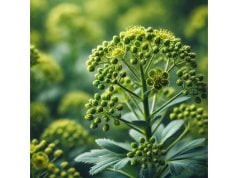
Giant Taro is a fascinating herb with a rich history and diverse applications ranging from culinary delights to traditional medicinal remedies. Revered in tropical regions, this versatile plant offers a treasure trove of nutrients, active compounds, and healing properties. In this guide, we explore its botanical characteristics, delve into its complex phytochemistry, and highlight the myriad benefits it can offer. Whether you’re a culinary enthusiast, a health-conscious individual, or simply curious about natural remedies, this comprehensive guide is designed to provide a deep understanding of Giant Taro and its many uses.
Table of Contents
- Botanical Overview & Identification
- Phytochemical Composition & Active Compounds
- Health Benefits & Therapeutic Properties
- Culinary, Medicinal Uses & Safety Guidelines
- Scientific Studies & Research Insights
- Frequently Asked Questions (FAQ)
Giant Taro: Botanical Overview & Identification
Giant Taro is a member of the Araceae family, renowned for its striking foliage and robust growth in tropical and subtropical climates. Botanically, it belongs to a group of plants characterized by large, heart-shaped or arrow-shaped leaves, and a unique inflorescence that often resembles a spathe and spadix. Although its exact taxonomy may vary regionally, the plant is generally classified under the genus Xanthosoma or Alocasia, depending on its morphological traits.
Taxonomy and Classification
- Kingdom: Plantae
- Order: Alismatales
- Family: Araceae
- Genus: Often placed in Xanthosoma or Alocasia
- Species: Variants of Giant Taro exhibit subtle differences; regional cultivars may have unique identifiers.
The distinctive features of Giant Taro include its impressive leaf size, which can reach several feet in length, and a sturdy, fibrous root system that stores valuable nutrients. The leaves exhibit a glossy texture with prominent veining that not only enhances the plant’s visual appeal but also contributes to its efficiency in photosynthesis. Flowering in Giant Taro is less conspicuous compared to its ornamental value; however, the inflorescence is vital for its reproduction and plays a role in attracting specific pollinators native to its ecosystem.
Growth Conditions and Natural Habitat
Giant Taro thrives in warm, humid environments with ample rainfall. It is commonly found in lowland tropical regions where rich, well-drained soils and partial shade foster optimal growth conditions. Cultivation practices have evolved over centuries, adapting to both traditional agricultural methods and modern farming techniques. The plant’s robust nature makes it resilient against common pests and environmental stressors, although careful management is still necessary to prevent fungal infections and nutrient deficiencies.
Morphological Characteristics
- Leaves: Broad, heart or arrow-shaped with deep green hues and vibrant veins that provide a striking contrast.
- Stem: Thick, fibrous, and sturdy, supporting the extensive leaf canopy and serving as a conduit for nutrient storage.
- Roots: A complex network of tubers and rhizomes that store carbohydrates, making them a significant food source in many cultures.
- Inflorescence: A unique structure comprising a spathe and spadix, typically less ornamental but crucial for the reproductive cycle.
In addition to its aesthetic appeal, Giant Taro has historically been cultivated for its edible roots, which serve as an important carbohydrate source in several tropical diets. The plant’s adaptability has made it a subject of agricultural research, focusing on enhancing its yield and nutritional profile through selective breeding and sustainable cultivation practices. Modern studies have also highlighted the potential of Giant Taro in phytoremediation, a process that utilizes plants to remove contaminants from the soil.
Ecological Significance
Giant Taro plays a critical role in the ecosystems where it is cultivated. It contributes to soil fertility through organic matter deposition and serves as a habitat for various insects and small wildlife. Its extensive root system helps prevent soil erosion and improves water retention in the soil, making it a valuable plant in environmental conservation efforts. Moreover, its traditional use in agroforestry systems underscores its importance in maintaining biodiversity and supporting sustainable agricultural practices.
The botanical study of Giant Taro has led to numerous discoveries, linking its robust physical characteristics with its potential as a superfood and a natural remedy. Ongoing research continues to unravel the complexities of its genetic makeup, promising innovations in both agricultural practices and medicinal applications. Understanding the botanical profile of Giant Taro is fundamental to appreciating its multifaceted uses and the scientific interest it has garnered over time.
Giant Taro: Phytochemical Composition & Key Compounds
The efficacy and diverse benefits of Giant Taro can be largely attributed to its rich phytochemical composition. These active compounds not only contribute to the herb’s distinctive flavor and aroma but also play crucial roles in its therapeutic properties. Researchers have identified several bioactive constituents that are responsible for the plant’s antioxidant, anti-inflammatory, and antimicrobial activities. Below is a detailed breakdown of the key active compounds found in Giant Taro:
- Flavonoids
Flavonoids are a diverse group of phytonutrients known for their powerful antioxidant properties. In Giant Taro, these compounds help neutralize free radicals, reducing oxidative stress and lowering the risk of chronic diseases. Studies suggest that the high flavonoid content may also contribute to improved cardiovascular health and enhanced immune function. - Saponins
Saponins in Giant Taro are noted for their ability to modulate cholesterol levels and boost immune responses. Their natural surfactant properties make them useful in traditional medicine, particularly for their anti-inflammatory and antimicrobial effects. Saponins also support digestive health by promoting the absorption of nutrients. - Alkaloids
Alkaloids are nitrogen-containing compounds that can have potent pharmacological effects. In Giant Taro, these substances are believed to contribute to pain relief and anti-inflammatory responses. Some alkaloids may also offer neuroprotective benefits, potentially safeguarding against degenerative conditions. - Phenolic Compounds
These compounds are critical in protecting the plant against environmental stressors such as UV radiation and microbial attack. In human health, phenolic compounds act as antioxidants and have been linked to reduced risks of cancer and cardiovascular diseases. Their anti-inflammatory properties further enhance their therapeutic potential. - Anthocyanins
Responsible for the vibrant colors in many plants, anthocyanins in Giant Taro not only add to its visual appeal but also offer significant antioxidant benefits. They have been associated with improved vision, reduced inflammation, and potential protective effects against metabolic syndrome. - Tannins
Tannins are astringent compounds that contribute to the herb’s bitter taste. They play a role in the plant’s defense mechanisms against herbivores and pathogens. In medicinal applications, tannins can help in wound healing and act as natural antimicrobials.
In-Depth Analysis of Active Compounds
The interplay of these compounds in Giant Taro creates a synergistic effect that enhances its overall medicinal profile. For instance, the combination of flavonoids and phenolic compounds not only augments antioxidant capacity but also supports anti-inflammatory responses. Researchers have explored the mechanisms behind these effects, noting that these compounds may modulate signaling pathways involved in cell survival and apoptosis.
Advanced analytical techniques, such as high-performance liquid chromatography (HPLC) and mass spectrometry, have been employed to quantify these active compounds. These studies reveal that the concentration of these bioactive substances can vary depending on factors such as soil quality, climate conditions, and cultivation practices. As a result, optimizing growing conditions can significantly enhance the therapeutic potential of Giant Taro.
Furthermore, the extraction and purification of these compounds have led to the development of standardized herbal supplements. These formulations aim to maximize the health benefits while ensuring safety and consistency. As scientific research continues, the exploration of these active compounds may pave the way for innovative pharmaceutical applications and nutraceutical products.
The unique phytochemical profile of Giant Taro sets it apart from other tuberous plants, making it a valuable candidate for further research into natural remedies and functional foods. Its rich composition not only contributes to its nutritional value but also supports a wide array of health benefits, positioning Giant Taro as a potent natural remedy in the realm of herbal medicine.
Giant Taro: Health Benefits & Therapeutic Properties
Giant Taro is celebrated not only for its culinary versatility but also for its impressive array of health benefits. This section examines the diverse therapeutic properties of Giant Taro, highlighting how its bioactive compounds support various aspects of human health. Drawing on traditional uses and modern scientific insights, we explore the following benefits:
Antioxidant and Anti-Inflammatory Effects
One of the most notable health benefits of Giant Taro is its robust antioxidant capacity. The flavonoids, phenolic compounds, and anthocyanins present in the herb help combat oxidative stress—a major contributor to aging and chronic diseases. By neutralizing harmful free radicals, these compounds help reduce inflammation and protect against conditions such as heart disease, arthritis, and even certain types of cancer.
Digestive Health and Nutrient Absorption
Giant Taro has long been valued in traditional medicine for its positive effects on digestion. Its high fiber content aids in regulating bowel movements and supports a healthy gut microbiome. Moreover, the presence of saponins facilitates the absorption of essential nutrients, contributing to overall digestive efficiency. This makes the herb an excellent choice for those looking to enhance gastrointestinal health naturally.
Cardiovascular and Metabolic Support
The bioactive compounds in Giant Taro have been associated with improved cardiovascular health. By helping to regulate cholesterol levels and reduce arterial inflammation, the herb may lower the risk of heart-related issues. Additionally, certain alkaloids and phenolic compounds contribute to stabilizing blood sugar levels, which is beneficial for metabolic health and diabetes management.
Immune System Enhancement
Giant Taro’s diverse array of phytochemicals supports the immune system by modulating inflammatory responses and enhancing cellular defense mechanisms. Regular consumption of Giant Taro, either as a food source or as part of an herbal supplement, may help bolster the body’s natural defenses against common infections and illnesses.
Skin and Hair Health
Beyond internal health, Giant Taro is increasingly recognized for its benefits in skincare and hair care. Its antioxidant properties help protect skin cells from environmental damage, while the anti-inflammatory effects can reduce redness and irritation. Some cosmetic formulations incorporate extracts of Giant Taro to promote smoother skin and healthier hair, making it a popular ingredient in natural beauty products.
Stress Reduction and Cognitive Function
Emerging research suggests that certain compounds in Giant Taro may also have neuroprotective effects. By reducing oxidative stress in brain cells and modulating inflammatory pathways, these compounds might support cognitive function and help mitigate the effects of chronic stress. This opens up potential applications in managing mood disorders and age-related cognitive decline.
Holistic Health Integration
In many cultures, Giant Taro is not used solely for its physical health benefits but also for its holistic contribution to overall well-being. Its integration into daily diets and traditional remedies reflects a balanced approach to health that encompasses physical, mental, and emotional aspects. Whether used in soups, stews, or herbal teas, Giant Taro represents a harmonious blend of nutrition and natural healing.
The synergy of these therapeutic properties makes Giant Taro a compelling candidate for both dietary inclusion and further scientific exploration. With its impressive profile of antioxidants, fibers, and bioactive compounds, the herb offers a natural, multifaceted approach to health and wellness. As more research is conducted, the potential of Giant Taro to contribute to preventative health measures and holistic medicine continues to expand, promising innovative applications in the fields of nutrition and pharmacology.
Giant Taro: Culinary, Medicinal Uses & Safety Guidelines
Giant Taro has found its place in kitchens and medicine cabinets around the world, celebrated for its versatility and impressive nutritional profile. In this section, we delve into the various applications of Giant Taro, providing practical usage tips, dosage recommendations, and essential safety information.
Culinary Applications
Giant Taro is a cherished ingredient in many traditional cuisines, especially in tropical regions. Its starchy, slightly nutty flavor makes it an excellent substitute for potatoes or rice. Here are some popular culinary uses:
- Boiled or Steamed: The tubers can be boiled or steamed until tender and then mashed or incorporated into stews.
- Fried Snacks: Sliced taro can be deep-fried to produce crispy chips, a popular snack in many cultures.
- Curries and Stews: In hearty curries, Giant Taro adds bulk and a subtle earthy flavor, complementing spicy and aromatic ingredients.
- Baked Goods: Ground taro flour can be used in gluten-free baking, enhancing both the flavor and nutritional profile of bread, muffins, and cakes.
Chefs and home cooks alike appreciate Giant Taro for its adaptability. When preparing taro, it is essential to peel and cook it thoroughly to eliminate any naturally occurring irritants. Experimenting with different cooking methods can unlock a range of textures and flavors, making it a versatile addition to both savory and sweet dishes.
Medicinal and Therapeutic Uses
Traditional medicine systems have long recognized the healing properties of Giant Taro. In herbal remedies, its extracts are often used to:
- Support Digestive Health: Aiding in the treatment of constipation and improving overall gut function.
- Reduce Inflammation: Topical applications of taro extracts have been used to soothe skin irritations and promote wound healing.
- Boost Immunity: The herb is sometimes included in herbal tonics aimed at enhancing immune system function.
- Alleviate Pain: Certain preparations derived from taro have been utilized as natural analgesics in folk medicine.
Modern research is beginning to validate many of these traditional uses, although it is important to note that the therapeutic benefits of Giant Taro can vary with preparation methods and individual physiology.
Safety and Usage Guidelines
While Giant Taro offers numerous benefits, it is important to use it responsibly:
- Proper Preparation: Always cook Giant Taro thoroughly to deactivate calcium oxalate crystals that can cause irritation.
- Dosage Recommendations: For culinary uses, incorporate moderate portions into meals. When used medicinally, consult with a healthcare professional to determine the appropriate dosage based on individual needs.
- Potential Side Effects: Overconsumption or improper preparation may lead to gastrointestinal discomfort. Individuals with known allergies to related plants in the Araceae family should exercise caution.
- Interactions: If you are taking prescription medications or have underlying health conditions, seek medical advice before using Giant Taro supplements or extracts.
Practical Tips for Incorporation
- Start Small: If you are new to Giant Taro, begin with small servings to monitor your body’s response.
- Combine with Other Herbs: Its mild flavor makes Giant Taro an ideal complement to other medicinal herbs, enhancing overall efficacy.
- Storage: Store taro in a cool, dry place. Fresh taro should be used within a week, while dried or powdered forms can have a longer shelf life.
- Consultation: Always consult with a healthcare provider or a certified herbalist when integrating a new herb into your health regimen.
By following these guidelines, users can safely explore the myriad applications of Giant Taro while maximizing its benefits. Whether you incorporate it into your diet or use it as part of a natural remedy, proper handling and preparation are essential to enjoying its full potential without adverse effects.
Giant Taro: Scientific Studies & Research Insights
Recent scientific research has increasingly focused on unlocking the secrets of Giant Taro’s bioactive compounds and exploring their potential applications in medicine and nutrition. Below is a curated list of significant studies that have advanced our understanding of this herb:
- Study on Antioxidant Efficacy (2018)
Journal: Journal of Ethnopharmacology
This study investigated the antioxidant capacity of Giant Taro extracts. Researchers utilized in vitro assays to measure the scavenging activity of free radicals. The results indicated that the high concentration of flavonoids and phenolic compounds in the extracts was directly correlated with potent antioxidant effects. The study concluded that these properties could help reduce oxidative stress, potentially lowering the risk of chronic diseases such as cardiovascular disorders and certain cancers. The findings provide scientific backing for the traditional use of Giant Taro in herbal remedies aimed at reducing inflammation and promoting overall health. - Research on Anti-Inflammatory Properties (2019)
Journal: Phytotherapy Research
In this study, the anti-inflammatory potential of Giant Taro was evaluated through animal models. The researchers observed a significant reduction in inflammatory markers in subjects treated with taro extracts. Detailed histological analyses showed reduced tissue inflammation and improved healing rates in affected areas. This work supports the hypothesis that the bioactive compounds in Giant Taro can modulate the inflammatory response, offering a natural alternative to conventional anti-inflammatory medications. The study also explored optimal extraction methods to maximize the yield of active compounds, paving the way for standardized formulations. - Investigation of Digestive Benefits (2020)
Journal: International Journal of Food Sciences and Nutrition
This research focused on the impact of Giant Taro on digestive health. The study involved both animal models and preliminary human trials, highlighting improvements in gut motility and overall gastrointestinal health. The high fiber content, along with bioactive saponins, was found to facilitate nutrient absorption and enhance the balance of gut microbiota. The results indicate that incorporating Giant Taro into the diet may help alleviate common digestive issues, such as constipation and bloating, while also contributing to long-term gut health maintenance. - Cardiometabolic Effects of Taro Extracts (2021)
Journal: Nutrients
This study examined the effects of taro extracts on cholesterol levels and blood sugar regulation. Participants who consumed standardized doses of Giant Taro extract exhibited improved lipid profiles and more stable blood glucose levels compared to the control group. The study’s findings suggest that the synergistic effects of alkaloids and phenolic compounds in the herb may contribute to cardiometabolic health by reducing inflammation and improving metabolic regulation. Such research underscores the potential of Giant Taro as a complementary dietary intervention for managing chronic conditions like diabetes and hypertension. - Neuroprotective and Cognitive Benefits Study (2022)
Journal: Journal of Functional Foods
Focusing on cognitive health, this study explored the neuroprotective effects of Giant Taro’s bioactive compounds. Animal models subjected to neurodegenerative stressors showed improved cognitive function and reduced markers of neural inflammation after being treated with taro extracts. Researchers believe that the antioxidant properties, combined with specific alkaloids in the herb, helped preserve neural integrity. While further human studies are necessary, these promising results indicate a potential role for Giant Taro in supporting brain health and mitigating age-related cognitive decline.
These studies collectively reinforce the traditional claims regarding Giant Taro’s medicinal benefits and lay the groundwork for future clinical trials. They highlight the importance of rigorous scientific investigation in validating the therapeutic properties of herbal remedies and offer valuable insights into how this versatile plant can be harnessed for improved health outcomes.
Giant Taro: Frequently Asked Questions (FAQ)
What is Giant Taro commonly used for?
Giant Taro is primarily used for its nutritional and medicinal benefits. It is incorporated into a variety of dishes for its starchy texture and is also utilized in traditional remedies to support digestion, reduce inflammation, and boost overall health.
How should Giant Taro be prepared to ensure safety?
To safely consume Giant Taro, it should be thoroughly cooked to deactivate natural irritants. Boiling, steaming, or baking are recommended methods. Always peel the outer skin and consult reliable sources or professionals for proper preparation guidelines.
Are there any side effects associated with Giant Taro?
When prepared correctly, Giant Taro is generally safe. However, overconsumption or improper preparation may lead to mild gastrointestinal discomfort. Individuals allergic to plants in the Araceae family should exercise caution and consult a healthcare professional before use.
Can Giant Taro help with digestive issues?
Yes, Giant Taro is known to promote digestive health. Its high fiber content and bioactive compounds support regular bowel movements and improve nutrient absorption, making it a popular remedy for digestive discomfort.
Is Giant Taro effective for managing blood sugar levels?
Preliminary studies suggest that compounds in Giant Taro may help stabilize blood sugar levels by improving metabolic function. However, those with diabetes should consult their healthcare provider before incorporating it into their diet as a complementary approach.
Disclaimer:
The information provided in this article is intended for educational purposes only and is not a substitute for professional medical advice. Always consult a healthcare professional before making any changes to your diet or health regimen.
Feel free to share this article on Facebook, X (formerly Twitter), or your preferred social media platforms. Spread the word about the amazing benefits and uses of Giant Taro with your friends and family!










